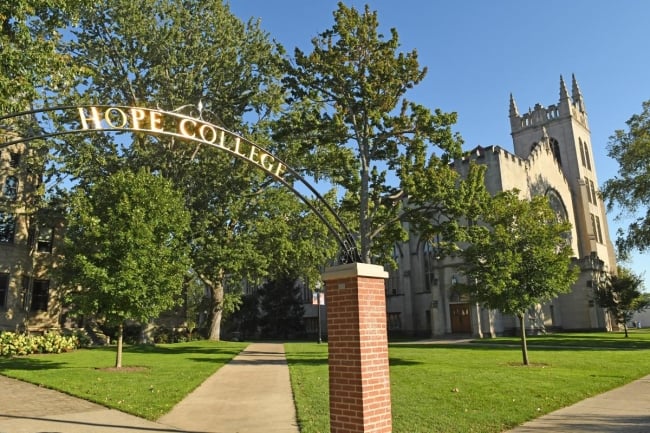You have /5 articles left.
Sign up for a free account or log in.

Hope College campus in Holland, Mich.
Courtesy of Hope College
Hope College wants to make tuition free for all its students.
The college announced Wednesday that it is moving toward a tuition-free financial model under which students will not be charged tuition and instead will be asked to donate money to the college every year after they graduate. The tuition revenue that the college has historically relied on to fund operations will be replaced by earnings on its endowment, which will have to grow significantly in order to make the new model sustainable.
The college won’t increase the percentage of endowment earnings it pulls to spend each year. Instead, it plans to increase the size of its endowment.
Over the course of the next decade, the small, Christian liberal arts college in Holland, Mich., aims to raise $1 billion -- enough money to fund tuition for all 3,000-plus undergraduates for years to come. Tuition for the 2021-22 academic year is $36,300. Ninety-seven percent of Hope students receive some kind of financial aid, whether institutional or federal, according to National Center for Education Statistics, or NCES. The college's average discount rate is 45 percent, meaning that for every $100 the college charges students in tuition, it also provides $45 in institutional aid.
“The current model essentially asks students to pay up front -- at the poorest point of their life -- an extraordinary amount of money,” said Matthew Scogin, president of Hope. “With this model students would come to Hope and Hope would fully fund their education up front.”
To start, a couple dozen students will have their tuition paid by Hope this fall. In return, the students will sign a commitment to give money to the college every year after they graduate. The commitment is not binding -- students can give whatever amount they choose and will not be punished for declining to give money postgraduation.
Interested students applied to be part of the tuition-free cohort. College officials asked applicants to write an essay about an area of hopelessness they wanted to bring hope to, Scogin said. Only students from outside the Midwest were invited to apply for the tuition-free trial run.
“We wanted to use this as a chance to expand our geographic diversity,” Scogin said. Most Hope students -- 68 percent -- come from within Michigan, according to the NCES.
If Hope is to extend its tuition-free model to cover all students -- and make it sustainable for years to come -- it needs to increase its $284 million endowment by $1 billion. The college has already raised $30 million toward that goal during a quiet phase of its fundraising effort.
Scogin is optimistic that donors will be excited about such an ambitious goal.
“Big ideas will attract people who are excited about making this happen,” he said. “I actually think it might be easier to raise a big amount of money for a big vision than to raise a medium amount of money for a medium-sized vision.”
Bill Stanczykiewicz, director of the Fund Raising School at Indiana University’s Lilly Family School of Philanthropy, said Scogin's prediction is sound and his optimism about raising the needed funds is realistic.
“Big donors get excited about big ideas,” Stanczykiewicz said. “And, in higher education, big donors love big ideas that involve students. And this is what Hope College is proposing.”
The tuition-free plan is not a ploy to increase enrollment, Scogin said. Hope’s enrollment has held relatively steady, hovering around 3,200 students over the past decade, NCES data showed. During the 2020-21 academic year, the college enrolled 3,060 undergraduates. This fall, college officials expect a 3,100 undergraduate student head count.
Scogin anticipates that the tuition-free model could improve student diversity at the college. Currently, the student body is overwhelmingly white -- more than four in five students are white. About 8 percent of students are Hispanic or Latino, 3 percent are two or more races, 2 percent are Black or African American, and 2 percent are Asian, according to NCES.
Hope’s incoming class is 20 percent nonwhite -- the college’s most diverse class to date.
The perpetuity of Hope’s tuition-free model -- even after the college raises the necessary funding to get it off the ground -- will depend on graduates giving back to the college.
College officials weren’t interested in a binding donation agreement or a minimum donation requirement.
“If we suggest an amount or a suggested percentage, well, then, all of a sudden it just starts to feel like a different flavor of student loan bills,” Scogin said. “The only thing we’re asking our students to commit to is to be philanthropic to Hope every year after they graduate. Whatever amount they decide to give -- that’s between them and God.”
Past research on alumni giving suggests that Hope's model could see mixed results, said Richard Steinberg, professor of economics, philanthropic studies and public affairs at Indiana University.
“Reciprocity is a strong motive for donors, but it’s not the only motive. It’s not even necessarily the strongest motive,” Steinberg said.
In one study, a college sent unsolicited gifts to potential donors. Some potential donors received high-quality gifts, while others received low-quality gifts. The study found that donors are twice as likely to give when they receive an unconditional, high-quality gift. In Hope’s case, the high-quality gift is a tuition-free college education.
“It’s not the same case, because they’re looking at people who’ve already graduated receiving gifts and responding that year,” Steinberg said. “But it’s a reason for hope” that the college’s plan could work.
Another study published in 2012 revealed a potential risk for Hope. Researchers looked at the impact of student financial aid packages on giving postgraduation and found that alumni who had received larger financial aid packages made smaller donations to the university after graduation, and that receiving financial aid had little bearing on whether or not an alum would donate.
At least one other institution, the Cooper Union in New York City, tried a similar funding model. The private college was tuition-free for undergraduates until 2014, when it started charging tuition amid revenue declines and mounting operating costs. College administrators say they plan to go tuition-free once again by 2028.
Despite the potential pitfalls, Scogin believes a tuition-free model is the right step for Hope and that it aligns well with the Christian college’s mission.
“It turns out, the Bible says a lot about money. And the Bible essentially says the purpose of money is to give it away,” he said. “This builds our entire financial model around giving and generosity.”








